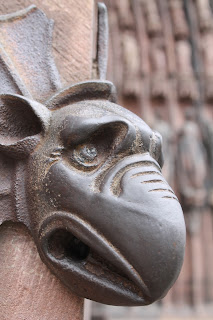I now begin a short series of essays about my trip to France. This
is why my blog has been silent for a while. Nobody
wants to read about “my trip to France” so I am writing essays about
science-related themes for which I found dramatic examples in France.
One thing France does better than America is cathedrals. Of course,
they’ve had centuries to get ahead of us (the Notre Dame cathedral in
Strasbourg just celebrated the 1,001st anniversary of the beginning
of its construction), and also the great era of cathedral-building, anywhere in
the world, is over. Yes, I am going to post some pretty pictures of cathedrals,
but for a very specific purpose.
Note: This is the Notre Dame cathedral in Strasbourg, not in Paris.
At the time the Notre Dame Cathedral in Strasbourg was built, it
encapsulated the entire world view of the people. The lofty ceiling reached to
heaven, and the windows were stained glass, which were brilliant in the photons
of sunlight but which totally blocked any photons of information from the outside world. When the peasants were inside
the cathedral, they could see nothing of the poverty or injustice forced upon
them by their society, nor could they see the beauty of trees or skies. And
when the rich people were inside the cathedral, everything they saw around them
made them think that they were chosen by God to dominate the vast majority of
people. To both rich and poor, the world of the cathedral represented all that
there was to know, or that was worth knowing. All they needed to know was
Biblical history presented in stained glass pictures, such as the story of
Jesus asleep in the boat, visible in one of the windows in this photo:
Meanwhile, high in the mountains of the Muenster Valley just
southeast of Strasbourg there is a little parish chapel. Instead of stained
glass, it has windows with full views of the beautiful mountains and green
fields and trees. The priest of that parish does not enforce a view of the
world, but lets the reality of the world shine in, and praises God for it.
The Strasbourg cathedral might, during the summer, have been the
only cool place in town, to which people retreated from the stress, dust, and
heat of everyday life. You could sit, or kneel, and feel at here, at this
place, all was right in the world.
And the cosmos too. The Earth was the center of the universe, and
everything in all of Creation revolved around us. Not only was all right in the
world, but in the cosmos as well. The Strasbourg cathedral had an Horloge
Astronomique, an astronomical clock, that celebrated what we now call the
Ptolemaic (earth-centered) view: the first clock was built in the 14th
century, the second in the 16th century.
This calm assurance changed toward the end of the middle ages.
Polish astronomer Mikolaj Koppernigk (Nicolaus Copernicus) showed that
astronomical observations could be neatly explained, without miracles or
special effects, by putting the sun in the center of what we now call the solar
system. The idea that the Earth was not the center of all of reality was a very
disturbing thought to late medieval people, and probably no ordinary person in
the cathedral had heard about it. But eventually everyone knew Copernicus was
right. While many Catholic astronomers merely admitted the fact, at least a few
others embraced it with enthusiasm. In 1843 the church hierarchy modified the Horloge
Astronomique, making it in effect a little shrine to Copernicus and the new
view of the universe!
The centerpiece of the 1843 clock is a sort of astrolabe, showing
the planets known at the time and their circular (unfortunately not elliptical,
it appears) orbits. Complicated gears keep the planets in their correct
relative locations. Off to the side is a painting of Copernicus. At the top is
a mechanical clock in which, every quarter hour, a death’s-head figure strikes
chimes and a figure representing somebody from every corner of society advances
across the front and disappear into the maw of mortality. (Every day at 12:30
tourists can purchase tickets to see the clock go through all of its movements
at once, but you can stand around and watch some of them at any time during
your free visit.)
This clock represents a major advance, all too rare in religion, in
which new discoveries about the universe are incorporated nearly as doctrine
and treated as if they had always been obvious. Too bad they don’t yet have a
shrine to Darwin. I’d be glad to send them some ideas for such a shrine if they
would like. Amoebas at the base, a panoply of dinosaurs in the middle, and each
hour a disc rotates with flying monkeys. A portrait of Darwin off to the side,
not at the top. On the top would be a line of humans, not the old and incorrect
progression of monkey to white man that you can still find in lots of books and
websites, but a range of equal humans, standing side by side, all races and
genders, looking confidently at the world, arms interlocked in peace.

















No comments:
Post a Comment